#double vertebrae fossil
Explore tagged Tumblr posts
Photo

Double Plesiosaur Vertebrae Fossil, Oxford Clay, Jurassic Stewartby UK | Articulated Marine Reptile + COA
Double Plesiosaur Vertebrae – Oxford Clay Formation, Callovian Stage, Middle Jurassic, Stewartby, Northamptonshire, United Kingdom
This impressive fossil consists of two Plesiosaur vertebrae originally found articulated and separated during professional preparation. These vertebrae come from the Oxford Clay Formation, dating to the Callovian stage of the Middle Jurassic, approximately 165 to 160 million years ago, and were discovered near Stewartby, Northamptonshire—an area historically significant for vertebrate fossil finds.
Fossil Type & Species:
Type: Vertebrate Fossil (Plesiosaur Vertebrae – originally articulated)
Clade: Sauropterygia
Order: Plesiosauria
Superfamily: Plesiosauroidea or Pliosauroidea (specific assignment undetermined)
Common Name: Plesiosaur (Marine Reptile)
Described by: Many species described from Oxford Clay, including Cryptoclidus, Muraenosaurus, and Peloneustes by early palaeontologists like Seeley and Owen
Geological & Stratigraphic Details:
Location: Stewartby, Bedfordshire–Northamptonshire region, UK
Formation: Oxford Clay Formation
Geological Stage: Callovian (Middle Jurassic)
Age: ~165–160 million years ago
Biozone: Peltoceras athleta ammonite zone (regionally correlated)
Depositional Environment: Shallow marine basin with low-oxygen bottom waters, ideal for the preservation of vertebrate remains in finely laminated marine mudstones
Morphology & Features: These two vertebrae exhibit classic plesiosaurian traits:
Cylindrical centra with concave articular surfaces (amphicoelous)
Flat dorsal and ventral surfaces typical of marine-adapted vertebrates
Distinctive surface texture and bone grain, with no artificial reconstruction
Separated from one another during cleaning but originally discovered as an articulated pair
Natural coloration in earthy browns and greys from mineral-rich clay matrix
Notable: Plesiosaurs were among the dominant marine predators of the Jurassic seas. Their fossils are relatively scarce compared to ammonites and invertebrates, making vertebral specimens highly desirable. Double vertebrae finds—especially originally articulated—are rarer still and represent a more complete snapshot of the animal’s skeletal structure.
Specimen Details:
Origin: Stewartby, Northamptonshire, UK
Fossil Type: Double Plesiosaur Vertebrae (Marine Reptile)
Geological Stage: Callovian, Middle Jurassic
Formation: Oxford Clay
Preservation: Originally articulated; now cleaned and separated but displayed together
Size Reference: Scale cube = 1cm (see photos for full sizing)
Note: The exact specimen shown in the photo is the one you will receive
Authenticity & Quality: This fossil is 100% genuine and has not been restored or artificially altered. It comes with a Certificate of Authenticity and was professionally cleaned to preserve anatomical detail.
Why Choose This Fossil? Perfect for:
Serious fossil collectors and palaeontology enthusiasts
Museum-quality marine reptile displays
Educational exhibits on Jurassic marine ecosystems
Rare vertebrate fossil investment
Shipping & Packaging: We ship using eco-conscious materials and track all deliveries. Each fossil is packed securely and handled with care.
Secure a rare piece of Jurassic marine history with these authentic Plesiosaur vertebrae from the Oxford Clay of Stewartby.
All of our Fossils are 100% Genuine Specimens & come with a Certificate of Authenticity.
#Plesiosaur vertebrae fossil#Jurassic marine reptile bones#Oxford Clay plesiosaur#Stewartby fossil reptile#double vertebrae fossil#real plesiosaur bone UK#fossil with COA#marine reptile vertebrae#Jurassic Northamptonshire fossil#articulated plesiosaur vertebrae#Oxford Clay fossil vertebra#UK plesiosaur specimen#Jurassic vertebrate fossil#collector fossil reptile bones
0 notes
Text
Brontosaurus
Source: IMPROVISED PLAY #54 | "The Enigma Of The High Visionary"
Sam makes two incorrect claims here. One: brontosaurus and diplodocus fossils have been “fused” together. Two: the brontosaurus wouldn’t have been able to support its own head.
So, let’s start with the first of Sam’s claims. “Then it’s neck would actually be able to support its weight because of its massive size.” Are you sure about that?
“[… Brontosaurus] carried paired spines, resulting in a wide and deep neck. […] Vertebrae in the neck, torso, and sacrum of sauropods bore large pneumatic foramina on their lateral sides. These are used to lighten the bones which aided in keeping the animal lighter. Within the vertebrae as well, smooth bone walls in addition to diverticula would make pockets of air to keep the bones light.” Additionally, “These parapophyses in conjunction with dense diapophyses and cervical ribs were strong anchors for neck muscles, which could sustain extreme force. […] Despite its pneumaticy, the neck of Brontosaurus is thought to have been double the mass of that of other diplodocids due to the former's sturdiness.” (source: wikipedia)
Okay, so we have paired spines, a thick neck, pneumatic foramina, air pockets, neck muscles able to sustain great force, and extra sturdiness. Great! The problem Sam has is that the neck wouldn’t be able to hold the head. Stronger muscles + lighter bones = a pretty strong neck, wouldn’t you say? Besides, the same Wikipedia article says “The skull of Brontosaurus has not been found but was probably similar to the skull of the closely related Apatosaurus. Several skulls of Apatosaurus have been found, all of which are very small in proportion to the body.” While not a brontosaurus skull itself, the skull of a close relative does sound like a valid size comparison. Case closed, let’s move on.
“There’s a lot of brontosaurus and diplodocus that have been actually fused together.” This one I can admit may have some truth to it.
“However, in 1903 paleontologist Elmer Riggs studied the same remains and found that they were virtually identical to Apatosaurus, a species of long-necked dinosaur that had been described by Marsh in 1877. Riggs concluded that both specimens were the same species and that since Apatosaurus was named first, Brontosaurus should be re-labeled Apatosaurus (convention among Paleontologists is that the first name gets precedence).” Okay so, over a century has passed, why do we still call them ‘brontosaurus’? “Then, just 20 years after the debate had finally been settled, a study published in 2015 suggested that the Brontosaurus skeleton originally described by Marsh is indeed distinct enough from Apatosaurus to be classified as a separate species. Not only that, but several other specimens that had previously been identified as Apatosaurs were found to belong to two distinct subspecies of Brontosaurus.” Technically, it’s still up in the air whether brontosaurus and apatosaurus are separate species or not. But the most recent information we have points toward the separation, rather than against it. (source: Houston Museum of Natural Science) (more info on the study: Scientific American)
Conclusion: ❌Bullshit❌
#sam lies#the enigma of the high visionary#sam russell#sfthposting#sfth sam#shoot from the hip#shootimpro#sfth#brontosaurus#also I saw someone mentioning me in Luke’s qna. I love that so much#Emma. you are a queen#you were spamming the chat#I love you Emma
74 notes
·
View notes
Text










Switzerland’s most surreal bar is located in Gruyère and was founded to honor the legendary gothic artist and Alien character designer HR Giger. The bar is located within a museum dedicated to the artist with the interior of the otherworldly environment: a cavernous, skeletal structure covered by double arches of vertebrae that crisscross the vaulted ceiling of an ancient castle. The sensation of being in this extraordinary setting recalls the tale of Jonah and the whale, lending the feel of being literally in the belly of a fossilized, prehistoric beast, or that you have been transported into the remains of a mutated future civilization.
There was a similar unauthorized Giger tribute bar set up in Tokyo in the 1980s but it was shuttered once the Yakuza mafia developed a liking to the place and took it for themselves.
#hr giger#alien#hr giger bar#switzerland#gruyère#aesthetic#vintage#old school cool#style#gothic#design
92 notes
·
View notes
Text

D-Diplodocus
1. Classification: Diplodocus belongs to the sauropod group of dinosaurs, which are characterized by their long necks, long tails, and massive bodies. 2. Size: Diplodocus was one of the longest dinosaurs, with estimates suggesting it could reach lengths of up to 80-90 feet (24-27 meters). Despite its length, it was relatively lightweight for its size, weighing between 10 to 20 tons.
3. Period: Diplodocus lived during the Late Jurassic period, approximately 155 to 145 million years ago.
4. Habitat: Fossil evidence suggests that Diplodocus inhabited what is now North America, particularly in the area that is now the western United States, including Colorado, Montana, Utah, and Wyoming.
5. Diet: As a herbivore, Diplodocus primarily fed on plants. Its long neck allowed it to reach high vegetation, as well as low-lying plants.
6. Anatomy: Diplodocus had a long, whip-like tail, which it might have used for defense or communication. Its neck was also extremely long, consisting of at least 15 vertebrae.
7. Skull and Teeth: The skull of Diplodocus was small compared to its body, with peg-like teeth that were likely used to strip leaves from branches.
8. Movement: It is believed that Diplodocus moved on all fours, but there is some evidence suggesting it could rear up on its hind legs to reach higher vegetation.
9. Discovery: The first Diplodocus fossils were discovered in 1877 by Samuel Wendell Williston in Colorado. The genus name, Diplodocus, was given by paleontologist Othniel Charles Marsh in 1878, meaning “double beam” in reference to its double-beamed chevron bones located on the underside of its tail.
10. Cultural Impact: Diplodocus has become one of the most well-known dinosaurs, often featured in museums, literature, and media. One of the most famous specimens, nicknamed “Dippy,” has been a central exhibit in the Natural History Museum in London.
19 notes
·
View notes
Text
(SOLD)- Chaplet of Sirona


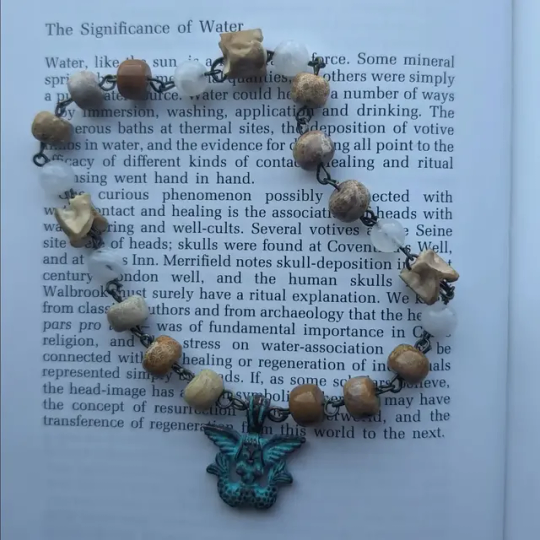
snake vertebrae, moonstone, fossilized coral
A chaplet dedicated to the dewoi of stars, springs, and healing, Sirona. Worshipped by the continental celtic people, the goddess Sirona was petitioned for miracles of health. Contemporarily, Sirona is often viewed as an ouranic and ocean dwelling dewoi, so this double tailed and winged mermaid amulet felt the perfect fit to depict the goddess.
Sirona's traditional attributes of the serpent and basket of eggs, the venom and the remedy, are represented here by snake vertebrae and milky white moonstones. The fossilized coral is meant to represent her connection the waters, and I hand picked specimens which reminded me glittering stars in all their many hues.
This piece, completed under the full moon, was blessed with lunar oils (as I am among those Gauls who see Sirona as a lunar-spirit), and other appropriate stellar materials. A prayer recited over each bead as it was passed over a fumigation of mugwort.
$78
#gaulish polytheism#rosary#pagan rosary#witchcraft#pagan#gaulish#moon goddess#star goddess#ocean goddess
14 notes
·
View notes
Text
Daily Dino Dose!
🦕 today's dino is the Diplodocus 🦖
(: because I do love them spaguetti shaped animals :)
This absolute unit of a reptile lived in the late jurassic period and was equipped with four sturdy as heck legs, a tiny head, a tail with 80 vertebrae that may have been used as defence or making some type of noise similar to a whip -kinky- and one, i repeat, ONE claw on it's front paw. Scientists are still debating its use but in my opinion it would've been used to flip other jealous sauropods that didn't have it.
The Diplodocus was more on the chill side and as such chose to have a diet which consisted of plants, chomping on trees and bushes, but alas, it was "not like other sauropods" and chose an unilateral stripping method for eating. This shows because its teeth have a different shape from its cousins and even from its young, this strategy was made so that there were no food competitions between species or age groups.
Diplodocus means "double beam", relating to its uncommon structure observed on the tail bones, but truth be told its discovery story is unfortunately not so rare. Discovered in 1877 during the Bone Wars it ended up caught up in, you guessed it, a scientific feud once again, between classifications and the second dinosaur rush a complete mould was finally exposed in 1899 as Diplodocus longus.
There are 4 possible species but only 2 are recognized (D.carnegii and D. hallorum). The main difference between the two is the amount of fossils, while D.carnegii had a full skeleton known -aka Dippy-, D. hallorum is composed of a few vertebrae and minor skeletal parts which are not enough to determine its position.
By being part of the most well known and recognizable dinos due to the amount of remains found including bones -duh-, footprints and even skin impressions, it's again, a character present in the BBC documentary Walking with Dinosaurs.
-for me it's one of the cutest episodes bcz tiny spaguettis :(( -

thank you for surviving my awful writing and sorry for any mistakes be it factually or grammatically and please let me know if there are any alterations that'd make this posts better, have a good one my pre-historic friends <3
#dinosaurs#daily dino dose#dailydinodose#prehistoric#fossils#prehistoric animals#paleontology#diplodocus#sauropod
19 notes
·
View notes
Text
FOSSIL FRIDAY: DIPLODOCUS
Diplodocus, the "double beam" in reference to it's double-beamed chevrons on the caudal verts. It was discovered by S.W. Williston
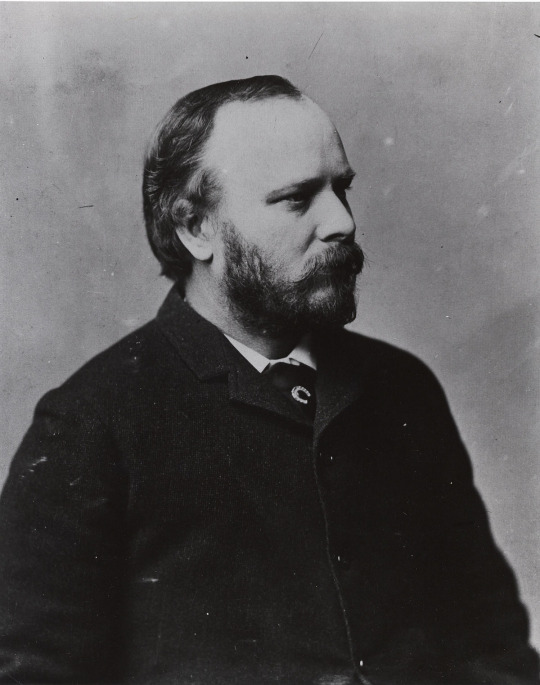
and named by Othniel Charles Marsh.
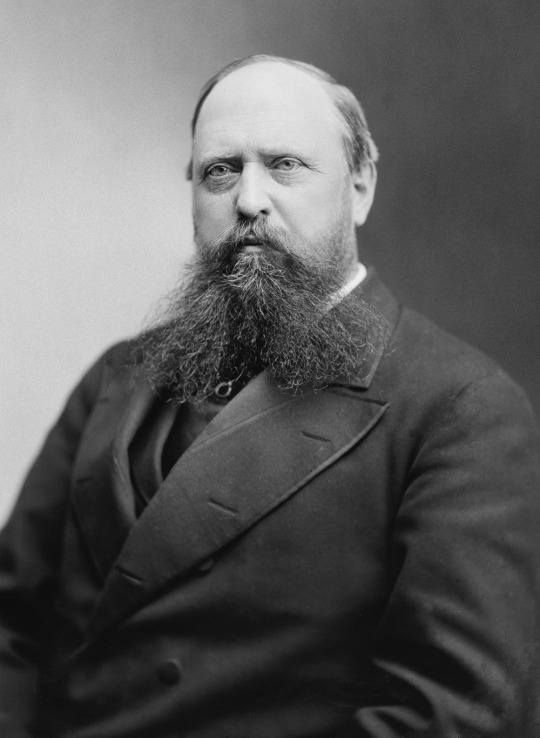
It is from the Late Jurassic Morrison Formation of North America.

Diplodocus carnegii is one of the longest dinosaurs known from a complete skeleton. It's tail is composed of 80 caudal verts.
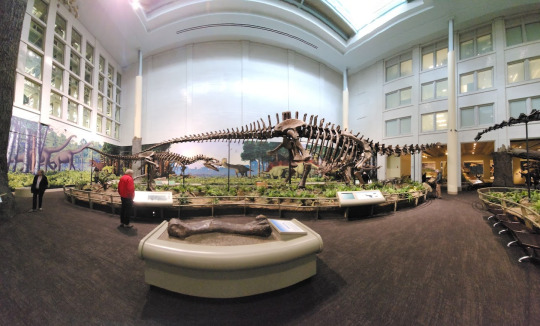
It has been speculated that the tail could have been used as a defensive or noise making weapon, that it could be used much like a whip. Or it simply was a counterbalance for the neck.
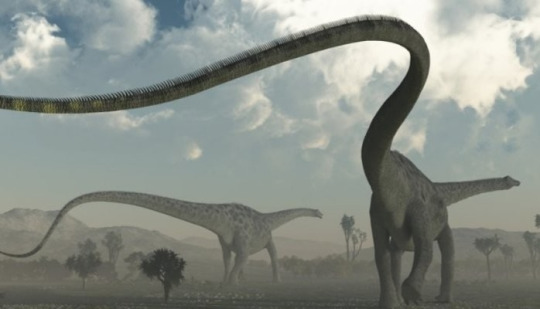
There is a 2015 paper by Foth et al that seems to indicate the weaponized use of the tail. They never outright say a sauropod did it, but the Allosaurus in question had damage on it's scapula and all it's ribs on the left side and that it was caused by a sudden traumatic event, such as getting the smackdown from an angry diplodocid. But that's just my opinion. Then again, I also think the whip-cracking would be cool too.

Diplodocus has some other cool features too. It has a single large claw on each front foot that we have no idea what it's used for yet.
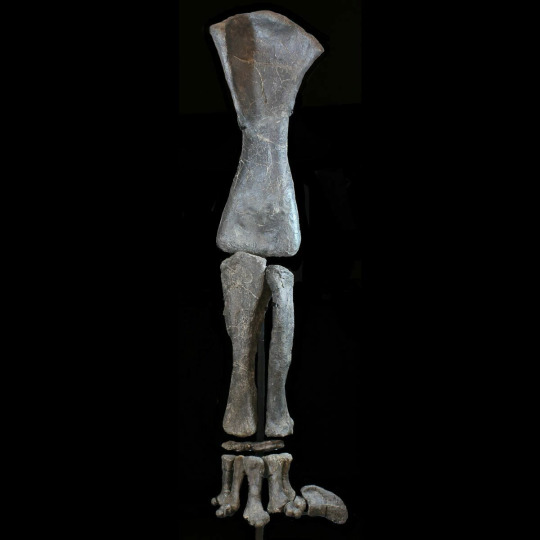
It has 15 cervical verts in its neck at least and we have found skin! Look at all the fun patterned skin!
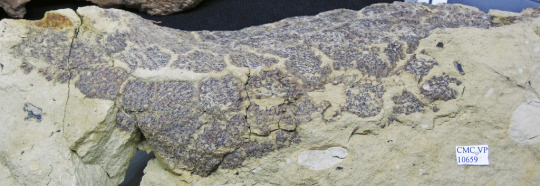
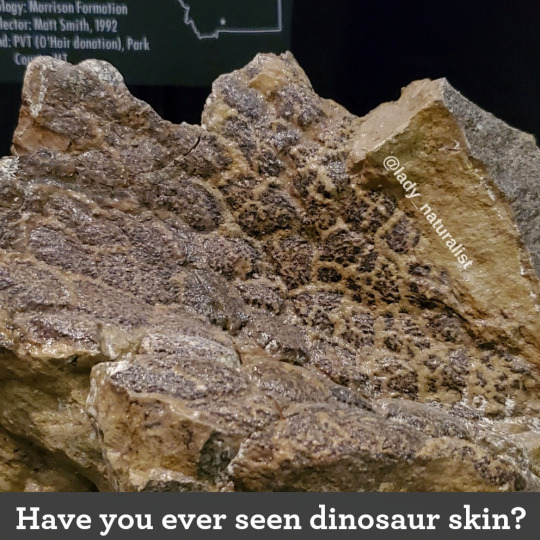
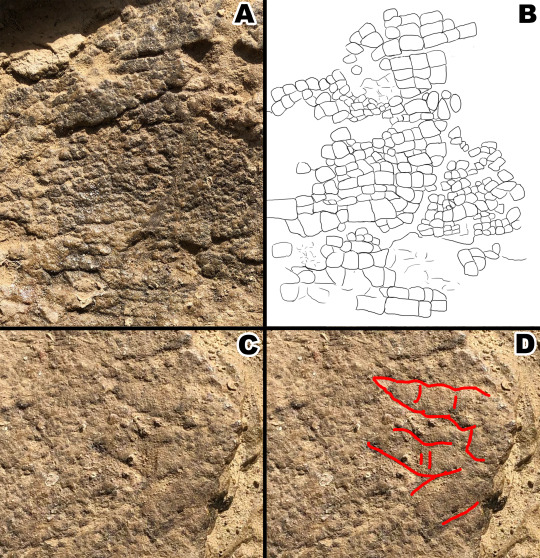
Finally, like all sauropods, it has pneumatic vertebrae. This means they were full of holes that would connect to the respiratory system, just like in birds.
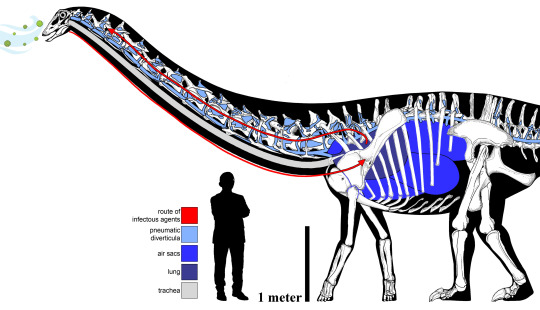
There has been some debate over the years about how Diplodocus and it's relatives would have held it's neck and head. Some believe they could hold it up to browse high branches.
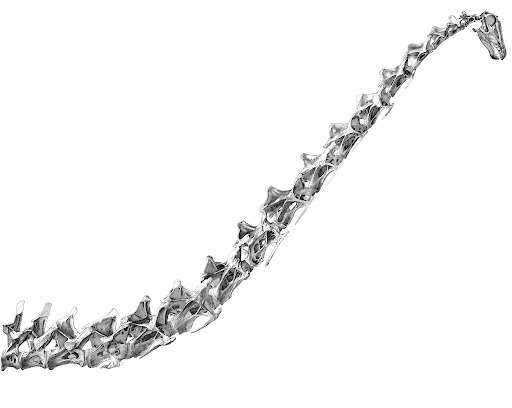
Others believe they didn't have the flexibility and simply help them horizontal to the ground.

Personally, I think it's probably a little of both. It makes the most sense in my head. Why have a long neck if you can't take advantage of the food? Which leads to another debate: could they tripod feed? Meaning, could they rear up and use their tail to as a sort of seat?
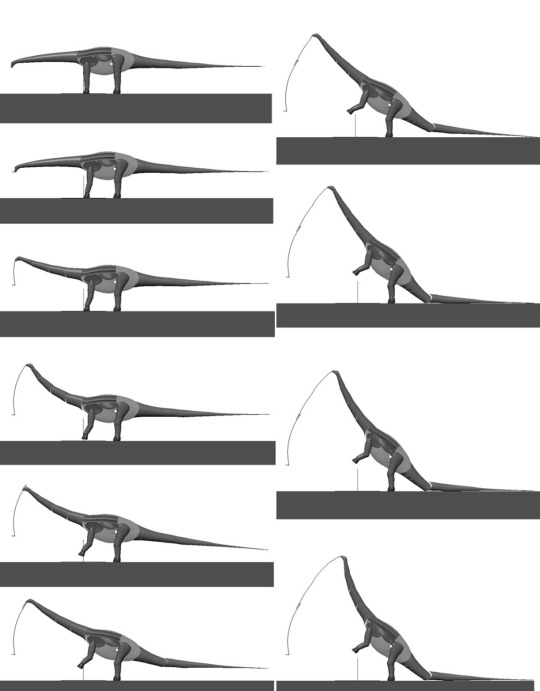
It might actually be possible. The base of the tail is incredibly muscular and can take a lot of stress. An important part of feeding is teeth and Diplodocus and fam had some weird teeth compared to other sauropods. They were long and skinny.
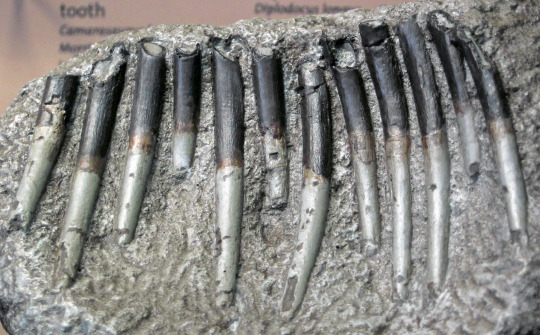
I mean, look at these suckers! The wear on said teeth showed that the used unilateral strip-feeding. Ever strip leaves off of a tree branch as a kid with one hand? Yeah, kinda like that but with their mouths instead.
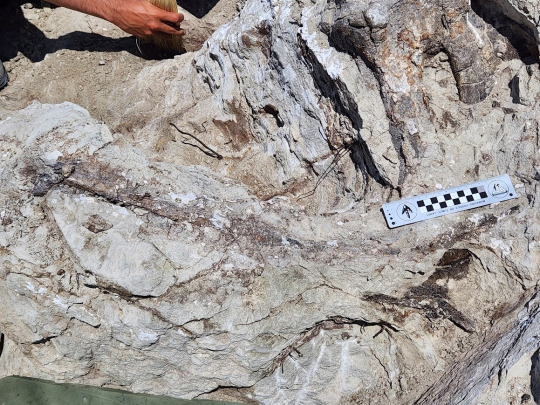
See that vert in the upper righthand corner? That's our diplodocid at the Evil Tree Bonebed site. It's still very much stuck in the ground along with a few friends it's articulated to. If you need something to do this upcoming July, come help us get her out! Check out the link and come join us! The more hands we get, the more stuff we can pull out!
5 notes
·
View notes
Text
Welcome to the Juras-Sick Park-Cast podcast, the Jurassic Park podcast about Michael Crichton's 1990 novel Jurassic Park, and also not about that, too.
Find the episode webpage at: Episode 40 - Control.
In this episode (stream it here!), my terrific guest Dr. W. Scott Persons IV joins the show to chat with me about:
field trips, othnielia vertebrae, splitting and lumping, The Lance Formation of Wyoming, nodosaurs, ichnofossils, ankylosaur osteoderms, hair-pulling and cringey moments in Jurassic Park, Nedry holding his own entrails, dinosaurs in media, The Land Before Time, incredible technology in the novel, like the fax machine!, studying dinosaur locomotion, the mighty caudofemoralis, comparative anatomy, running hadrosaurus and running tyrannosaurs, can T. rex run 40 mph?, reduced tyrannosaur arms, Yutyrannus arms, tails, spinosaurus tails, leaellynasaura tails, the evolution of feathers, looking for rictal bristles in super-primitive dinosaurs without feathers, injured allosaurus pubes, a detailed description of stegosaur tails, and much more!





Plus dinosaur news about:
The Double Dinosaur Brain Myth
Allosaurus Died From Stegosaur Spike to the Crotch, Wyoming Fossil Shows


Featuring the music of Snale https://snalerock.bandcamp.com/releases
Intro: Latebloomer. Outro: Grow Old Or Don't.

The Text:
This week’s text is Control, spanning from pages 218 – 220.Synopsis:
Harding, Sattler and Gennaro follow the compys through the park, but just as they’re about to discover the compys were scavenging on Dennis Nedry, and find the stolen Jeep with the rocket launchers in it, they are summoned back to the Visitor Centre, so Muldoon can use the jeep. Meanwhile, John Arnold begins his unenviable task of searching through the computer’s code to undo what Dennis Nedry’s done.

Discussions surround: God complex, Chaos Theory, and the Island Layout.
Corrections:
The character Dr. Robert Burke from The Lost World (1997) identifies the procompsognathus triassicus correctly. I was entirely mistaken to believe that it was called something else without double-checking the source text. My bad.
I also called The Lost World a 1995 film which The Lost World is not. The novel came out in 1995, the film came out in 1997.
Side effects:
May cause you to mythically believe in a second brain in your hips, and tingling in your phantom tail.
Find it on iTunes, on Spotify (click here!) or on Podbean (click here).
Thank you!
The Jura-Sick Park-cast is a part of the Spring Chickens banner of amateur intellectual properties including the Spring Chickens funny pages, Tomb of the Undead graphic novel, the Second Lapse graphic novelettes, The Infantry, and the worst of it all, the King St. Capers.
You can find links to all that baggage in the show notes, or by visiting the schickens.blogpost.com or finding us on Facebook, at Facebook.com/SpringChickenCapers or me, I’m on twitter at @RogersRyan22 or email me at ryansrogers-at-gmail.com.
Thank you, dearly, for tuning in to the Juras-Sick Park-Cast, the Jurassic Park podcast where we talk about the novel Jurassic Park, and also not that, too. Until next time!
#JurassicPark #MichaelCrichton
#dinosaurs#youtube#jurassic park#michael crichton#dinosaur movies#dinosaur#podcast#paleontology#stegosaurus#allosaurus#procompsognathus#compys#booktube#book tube#fyp#tyrannosaurus#Muldoon#Sattler#Tim and Lex Murphy
1 note
·
View note
Text
The mystery of Raptorex (LHPV10)
This small dinosaur lived during the early Cretaceous (130 million years ago) near China. Or not. Maybe it lived in Mongolia and died almost at the end of Cretaceous, about 70 million years ago.
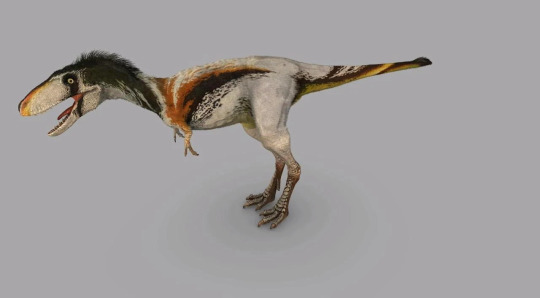
Presenting LHPV10, fossil remains of a single specimen that Paleontologists have been trying to figure out for over a decade. Some say that it is a juvenile Tarbosaurus Batar. While others say that is the only specimen of a completely new dinosaur called Raptorex Kriegsteini. The only thing that scientists agree upon is that it was a meat eating theropod dinosaur. Why is there so much confusion about this 10 ft long, 65 kg dinosaur? Keep reading to find out.
The first reason is that this specimen was dug up by private collectors and changed some hands before coming to University of Chicago. Which makes it almost impossible to know where the fossil was dug up. Without knowing where and from which strata the fossil was found in, aging the dinosaur becomes extremely difficult. Carbon dating, which is a very popular form of dating, can give an absolute date of up to 50,000 years ago. Anything older than that cannot be dated using Carbon dating. In absence of that, Paleontologists date the rocks around the fossils. But, in case of LHPV10, no one knows where it was found and hence, no rocks to date. So the Paleontologists tried to determine the age of the dinosaur using relative dating where they looked at the other fossils found around the fossil in question. Luckily, even though most of the sediments around the fossil had been removed by the time it came to Chicago, a single vertebra of a fish was found in the sediments that the fossil did have. In 2009, the first team, led by Paul Sereno, said that this vertebra belonged to a fish called Lycoptera which lived from late Jurassic to early Cretaceous (150mya-130mya). Lycoptera was abundant in China and hence, Sereno's team came to the conclusion that this dinosaur lived in China about 130mya. And despite it's similarities with a juvenile Tarbosaurus, this age put the dinosaur way before Tarbosaurus came into the picture. Hence, it had to be a new species that was named Raptorex. Later, Fowler looked into the same vertebra and inferred that it came from a completely different fish, a double-armored herring, that lived from 130mya-50mya. The team spoke to a private fossil collector who hinted that the fossil came from Mongolia, from a formation that has been dated to late Cretaceous (75-70mya). In addition to these problems, there are issues with whether the dinosaur is an adult or a juvenile. It is an important distinction because there have been cases where a dinosaur fossil has been given a whole new name and classification, only to be found later that it was a juvenile of an already known dinosaur. Sereno's team concluded that the fossil bones were fused enough that it was maybe 5-6 years old, making it a sub-adult. Fowler's team disagreed and posited an age of 3-6 years old. And based on its similarities with Tarbosaurus Batar, they concluded that Raptorex was actually a baby Tarbosaurus, a genus that lived around 70 million years ago. Well, whatever this dinosaur is, it has stumped Paleontologists for sure.
8 notes
·
View notes
Text
The Bromacker Fossil Project Part III: Fossil Preparation
Most of the important fossil discoveries from the Bromacker quarry, located in the Thuringian Forest, central Germany, were shipped to the Carnegie Museum of Natural History (CMNH) for scientific preparation. Between 1993 and 2005 I was the principal preparator of Bromacker fossils.
At CMNH the arrival of a field season’s worth of fossil crates was highly anticipated by Curator Dr. Dave Berman and myself. I’d be often notified of the crate’s early morning delivery by either a grinning security guard or shipping and receiving personnel upon my arrival at the museum. Later that day it would take a team of able-bodied staff from various departments to move the crate from the loading dock to the basement preparation lab, and to lift the plaster and burlap encased block from the crate onto a table.

My work area in the basement preparation lab. The table in the center is my main work table and is a made from a dentist chair. The blue cabinet with a hose extending from it is a dust collector, and the microscope (seen at the end of the hose) is mounted on an articulated arm to make it easier to maneuver over a block. Photo by the author, 2007.
The first step of the preparation process involved opening the block; that is, removing the top of the jacket. I’d use a cast cutter, the same tool doctors use to remove a cast protecting a person’s broken bone, to cut through the top perimeter of the plaster jacket. If all went well, the top would easily lift off the block. But if the top of the jacket stuck to the block or wedged in an undercut, I’d have to cut it into smaller pieces to remove it.

The block collected in the 2006 field season with its top removed. Exposed bone can be seen left of center. The blue tool resting on the surface of the block is a cast cutter.
Blocks from the Bromacker quarry typically have numerous cracks coursing through them, which must be stabilized before preparation begins. The product Carbowax works well for filling cracks, because, unlike plaster, it doesn’t shrink when it solidifies. Carbowax comes as a powder, which I’d melt it in a double boiler. Before pouring the hot wax into a crack, I’d heat the surrounding rock with a heat gun so that the wax could penetrate additional cracks not visible from the surface. I’d typically repeat this process numerous times during the preparation process.

Using a heat gun to heat the rock before pouring wax into a crack. I’d have to carefully watch the direction I aimed the heat gun so that strands of burlap sticking out of the plaster jacket wouldn’t catch fire. Photo by Norman Wuerthele, 2007.

Spooning hot Carbowax into a crack. The spoon was heated beforehand so that the wax wouldn’t solidify on it. It was a delicate balance between getting the spoon hot enough so the wax stayed melted but not so hot that the spoon handle burned my hand. Photo by Norman Wuerthele, 2007.
Once the block was stabilized, I began removing rock to expose the fossil. Where thick rock covered the fossil - and it sometimes was more than six inches - I’d use a small hammer and chisel to chip away chunks of rock. As I’d get closer to the fossil, I’d switch to an airscribe, which can be likened to a miniature pneumatic jack hammer. Although fossilized bone from the Bromacker was softer than the surrounding rock, the airscribe would flake the rock from the fossilized bone, leaving behind a thin veneer of rock that I’d remove using a pin vise. I’d also use the pin vise to scrape rock from bone in tight and/or delicate areas, such as teeth. All this work was performed while looking through a microscope.

Pictured are the tools that I’d use the most when preparing Bromacker fossils. From bottom left to upper right: small hammer and chisel, three pin vises that hold a rod of tungsten carbide of varying thickness and ground to different shaped tips, and two airscribes. Photo by the author, 2007.
In the block pictured in this post, I could see some tips of some vertebral spines (these are the bumps that you feel down the midline of your back) poking from the rock surface, so I began exposing them first. Because I was working on an articulated specimen (one bone connected to the next bone), I exposed it from front to the rear by simply following one bone to the next bone.

The skeleton emerging from the rock—vertebrae, ribs, and the right upper arm bone (humerus) are visible. Notice also the tips of vertebral spines leading away from the exposed portion of the skeleton. The lines in the rock were made by the airscribe. The white substance along cracks is Carbowax. Photo by the author, 2007.

Closeup view of the right foreleg and ribs. Horizontal cracks underneath the fossil made preparation difficult, because they formed gaps underlying the bone. I had to build a dam (upper left) to contain the hot wax so that the wax would penetrate the horizontal crack underlying the bone, instead of running all over the block. Photo by the author, 2007.

More of the fossil skeleton is exposed, including the torso, the right foreleg, part of the left foreleg, and most of the left hind leg. Photo by the author, 2007.
Parts of the hind legs and tail were collected separate from the block, because rock pieces containing them inadvertently had been tossed on the dump pile. This occurred before the specimen had been discovered, and the bone in these pieces was covered by mud and dirt. Instead of gluing them back in the block before preparation, I prepared them individually at a table under the microscope, as it made for easier viewing. Once all the fossil had been exposed and prepared, I removed excess rock to make the block smaller and lighter weight.

My work on the block has been completed, except for adding some plaster bandages to the end where I had removed excess rock to make the block smaller and lighter. Photo by the author, 2007.
Dave Berman and I later transported to block to a colleague’s lab at the University of Toronto, Mississauga, Canada, where the lab staff and students completed detailed preparation and scientific illustrations of the specimen. This specimen along with several others were recently described as a new genus and species, Martensius bromackerensis, in a paper published in the Annals of Carnegie Museum. This ancient creature will be the topic of a future post. To whet your appetite, here is a link to the news release announcing the publication.
Amy Henrici is Collection Manager in the Section of Vertebrate Paleontology at Carnegie Museum of Natural History. Museum employees are encouraged to blog about their unique experiences and knowledge gained from working at the museum.
#Carnegie Museum of Natural History#Paleontology#Vertebrate Paleontology#Fossils#Scientific Research#Martensius Bromackerensis
20 notes
·
View notes
Text
Whale Vertebrae with giant Megalodon Tooth ~ Its fake, but still really badass
Whale Vertebrae with giant Megalodon Tooth ~ Its fake, but still really badass
https://lolzandtrollz.tumblr.com/post/185343692755/badass-fossil
That had to be the size of a double-decker bus! The Meg left us a clue at the scene of the crime and most likely he swam away with a belly full of the whale! 😝
[contentcards url=”https://www.fossilera.com/pages/megalodon” target=”_blank”]
Fact #10. The Megalodon Had About 276 Teeth In 5 Rows
Like modern sharks, the Megalodon…
View On WordPress
0 notes
Text
[Dinosaur 9] Diplodocus | Learning English and Science for kids
http://luonhay.com/dinosaur-9-diplodocus-learning-english-science-kids/
Tên Diplodocus xuất phát từ tiếng Hy Lạp và có nghĩa là 'xà kép', điều này nói đến xương có hình dạng lạ được tìm thấy trong đuôi Diplodocus.Diplodocus là một con khủng long nổi tiếng phổ biến trong phim ảnh, tài liệu, đồ chơi và được trưng bày trong rất nhiều triển lãm bảo tàng trên khắp thế giới.
https://www.youtube.com/watch?v=85BqW2f0PsQ
Sự thật về Diplodocus cho trẻ em
Một số lượng lớn các hóa thạch còn lại đã làm cho các nhà khoa học nghiên cứu về Diplodocus dễ dàng hơn nhiều khủng long khác.
Diplodocus đã sống ở một khu vực mà bây giờ là phía Tây Bắc Mỹ vào cuối giai đoạn Jurassic, khoảng 150 triệu năm trước.
Mặc dù những con khủng long dài hơn còn được khám phá ra, Diplodocus được cho là dài nhất trong nhiều năm.
Các nghiên cứu cho thấy, Diplodocus có thể dài đến 35m (115ft) và nặng khoảng 10 đến 15 tấn.
Diplodocus có đuôi dài chứa khoảng 80 đốt xương sống.
Nghiên cứu ban đầu cho thấy Diplodocus có thể bơi trong nước, nhưng những nghiên cứu gần đây đã chỉ ra rằng áp suất nước trên ngực sẽ làm cho Diplodocus khó thở ra khỏi lỗ mũi của nó.
Diplodocus Facts for Kids
The name Diplodocus comes from the Greek language and means ‘double beam’, this refers to strangely shaped bones found in the Diplodocus tail.
The Diplodocus is a well known dinosaur that is popular in films, documentaries, as toy figurines and has been featured in a large number of museum exhibitions around the world.
A large amount of fossil remains have made it easier for scientists to study the Diplodocus compared to many other dinosaurs.
Diplodocus lived in an area that is now western North America at the end of the Jurassic Period, around 150 million years ago.
Although longer dinosaurs have since been discovered, Diplodocus was thought to be the longest for many years.
Research suggests the Diplodocus could have been as long as 35m (115ft) and around 10 to 15 tons in weight.
Diplodocus had a long tail which contained around 80 vertebrae.
Early research suggested the Diplodocus might have swum in water but more recent studies have indicated that water pressure on the chest would have made it too difficult for the Diplodocus to breathe out of its nostrils.
0 notes
Text
'Toroceratops' is BUSTED. Conclusively.
Q: I have heard that the Jack Horner theory about Torosaurus being nothing more than old individuals of Triceratops is getting a lot of pushback. Paleo King, what are your views on the theory, and what does the evidence actually say? A: They are arm-waving. Horner actually has a pattern of doing this, it isn't the first time. Remember the “obligate scavenger T. rex”? Every piece of evidence Bakker, Currie, Weishampel, etc. looked at, Horner basically ignored or dismissed or even denied – even things as basic as eye socket shape – just to preserve his precious theory. Later Horner confessed that he “never liked T. rex anyway” (he was always primarily a duckbill specialist, whose best work was with the Maiasaura nests) and never took the “100% scavenger idea” seriously, he simply went on TV and made these claims because he wanted to stir debate and knock T. rex down a few pegs. But making an argument you know is weak simply to stir debate, is the most unproductive sort of debate there is. Paleo-trolling before there were tumblr and buzzfeed. You'd think his fans would have learned from that whole fiasco. Most of them don't even know it happened. Score? Hornerite groupies: 0. Horner: 1
As for the “Toroceratops” theory – although Horner (but moreso his former student John Scannella) actually published academic papers and piling up skulls on this new idea, unlike with the scevenging T. rex theory, the line of argument in the papers is hardly any stronger, and the piles of Triceratops and Torosaurus skulls he cites as proof, do not actually support his claims. The theory basically runs like this: Triceratops and Torosaurus are found in the same rock layers and general region, they look very similar, both have metaplastic bone in their frills indicating bone remodelling, hence “obviously” one must be a growth stage of the other. Except that there's no real conclusive proof for that argument. The fossil evidence in their papers is either circumstantial or not in support of their theory, and some of it is even heavily altered with plaster. The make conclusions about the skulls, which the skulls themselves actually contradict! Same can be said for much of their Pachy-stygi-dracorex theory, which makes a ton of assumptions based on casts, stress fractures, and artifacts of preservation rather than native features of the fossils, as well as for Fowler's "Haplo-Suuwa-Bronto-Diplodocus" faux-pas, where downright bizarre fictions like "weighted characters" and "selective parsimony" had to be invented to turn sauropods that are clearly NOT diplodocids into good little juvenile diplodocids (just ignore the fact that Haplocanthosaurus is also known from non-bifurcated adult neck remains too, right?).
Don't you get all bifurcated on me too now....
There's no way to prove that Torosaurus was simply an old adult Triceratops. There are some VERY irreconcilable differences and between the two, and some gaping holes and assumptions in their hypothesis - even if you use ontogeny to "rationalize away" some of the variation. How Jack Horner and his team can hope to bridge these holes in their theory, I honestly have no clue: 1. The changes required are too radical for an animal that is no longer juvenile and has no growing left to do in the postcrania. Such an extreme and late change in facial geometry is unknown in any ceratopsid. 2. Torosaurus is far rarer than Triceratops, too rare to simply be the same animal a few years older. 90% of Hell Creek's large herbivores are Triceratops, Torosaurus forms less than 1%. Some may argue that this is only because few herbivores survived to old age, or that older individuals were more vulnerable to be eaten rather than fossilized – but this is pure speculation, and reason # 4 forces us to discard this idea. 3. Torosaurus has many more epoccipitals than Triceratops - and not only that, their numbers are far more variable in Torosaurus (from 30 to 37), while Triceratops always has exactly 17 (except in elderly skulls where they are reabsorbed). Scannella at SVP claimed that "perhaps Triceratops split their epoccipitals in half to double the number" - something that I can only guess was tongue-in-cheek, since there is no specimen showing evidence for such "stud splits" in either Triceratops, Torosaurus, or any other ceratopsid, much less any dinosaur, period. It sounds even more ridiculous when you realize that Triceratops actually LOST frill studs as it aged, it didn't add new ones. Those near the bottom of the frill tended to disappear first, and in the most mature Triceratops skulls, all of them are gone. To add new frill studs would be a reversal of the entire Triceratops aging process. 4. Torosaurus has never been found in association with Triceratops. If they were simply aged Triceratops, they would realistically be found in the same herds/locations at least some of the time, especially if they were weaker than young adult Triceratops and needed the protection. This association has never been known to occur for Torosaurus. You just don't find them at the same dig sites as Triceratops. 5. Different head/body proportions, even discounting the frill. The Milwaukee specimen of Torosaurus [link] has larger skull (including jugals) than Triceratops, but much smaller postcrania. Doesn't make sense why an adult animal's individual bones would be smaller than those of a "juvenile". Of course Horner doesn't specify if his 30-footers are really juvenile Triceratops or middle-aged adults, he just claims Torosaurus are "old adults". Ok whatever. 6. Torosaurus is actually smaller than Triceratops. As in, the entire body except for the head, is smaller – every bone is smaller than in the most mature Triceratops. How can an “adult” of one species have a smaller body than the “young”, and even smaller limb bones, ribs, and vertebrae? (every postcranial element from Torosaurus indicates an animal 24 ft. long, not 30 ft. as in the most mature Triceratops skeletons! I know humans and some animals lose height as they age due to cartilage contraction, but shrink the femur, the ribs and the humerus? SERIOUSLY? These parts don't even have any metaplastic bone in Torosaurus, nor do they show any proof of bone reabsorption!) 7. Horner and Scannella have never done a histological age analysis on Torosaurus postcrania to actually prove that they are any older than the biggest accepted Triceratops specimens. This would be far easier than guessing age from the skulls, since as mentioned above, postcrania do not typically feature metaplastic bone or remodeling. Not that being older would actually prove that they're old Triceratops per se, but it would at least remove one huge logical impediment that stands in the way of Horner's theory being more accepted – on the other hand, a young age for these bones would nuke it. 8. Beak shape in complete skulls is radically different - Triceratops had a strongly hooked, recurved "eagle" beak, while Torosaurus has a much less curved "condor" beak that slopes downwards and forwards, the traditional Chasmosaurine beak design. The sloping “condor” beak is also present in Eotriceratops, which is otherwise far closer to Triceratops proportions than to Torosaurus – putting even more taxonomic space between them. 9. Nasal horn position (and snout/beak length ratio) differs between Torosaurus and triceratops. Torosaurus has shorter post-nasal-horn snout and a longer beak. No ceratopsian is known to radically change beak shape or beak/snout ratios when reaching maturity. 10. Even in very old Triceratops, Torosaurus-like features are extremely rare. The only Triceratops specimen that shows even remotely Torosaurus-like snout proportions and horns is the Torrington skull [link] , which is a very old adult with reabsorbed frill studs but NO fenestrae in the frill! This may be the most basal Triceratops morph, close to a fork with Torosaurus. Even so, the beak curvature is still not identical to Torosaurus. 11. There appears to be ontogenic variation within Torosaurus itself! [link] The Yale specimen, the MOR specimens, the Denver specimen and others all show a great deal of variation in epoccipital reabsorption and horn curvature - indicating that Torosaurus a unique creature that underwent ontogenic changes and growth stages of its own, and not merely a “final phase” of Triceratops. 12. There are other ceratopsids even closer to Triceratops (like Eotriceratops, Nedoceratops, and Ojoceratops) that don't fit comfortably in any part of Horner's ontogeny sequence. Nedoceratops is the real wild card, as Horner and Scannella claim it as proof of the Trikes aging into Toros - but while it has a few things in common with both, it fails dismally as a "midlife crisis" stage between the two, since it has a very odd mix of features that, taken together, make no sense in a Triceratops growth series. They are only found individually in Triceratops of completely contradictory age groups, and most of them are not found in Torosaurus at all. Nedoceratops has a very "perky" high horn angle completely inconsistent with the forward curvature of the horns themselves as well as the skull's advanced ontogeny, if one were following Horner's theory [link] to its logical conclusions. Its horns curve like an old Trike, but their bases are angled up and back like a baby Trike. It beak roughly follows Torosaurus (almost nothing else on its face does) and Eotriceratops, but is shorter than in either, and its frill is essentially a more compact version of Eotriceratops - far shorter and more compact than a Toro frill, yet obviously also older than many Toro frills, judging by its heavily reabsorbed epoccipitals. Its squamosals don't look like anything known in either Triceratops or Torosaurus. Horner and Scannella's nomination of this skull as an ontogenic “transition” from Triceratops-morphs to Torosaurus-morphs is laughable. There isn't a hint of Torosaurus in its short frill length, low epoccipital count, or steep horn angle, and especially not in the squamosal. There is also a second, larger skull that appears to be Nedoceratops - CMN 8862, which was once labeled "Triceratops albertensis". It has the same "perky" horns and the same short, upcurved, very un-Toro-like squamosal. Clearly this animal had a different ontogeny pattern as it grew than either Triceratops or Torosaurus. It likely branched off from the family tree sometime after Torosaurus and before Eotriceratops. 13. Fake plaster fillers are misleading. The beak of the YPM Torosaurus skull, as well as the horn tips and rear frill of some Torosaurus skulls and most of the Milwaukee specimen skull have been incorrectly reconstructed to look like Triceratops. Also the MOR skulls have a huge nasal boss in place of a horn, which is not consistent with anything seen in Triceratops, least of all the beak structure. It's actually a bit shocking how the most commonly pictured Torosaurus skulls have FAKE BEAKS and FAKE skull fullers in general that are modeled on Triceratops skulls, rather than more complete Torosaurus skulls - GetAwayTrike faithfully reproduces both the complete skulls and the fragmentary ones with fake Triceratops-mimic plaster fillers (recurved eagle beaks, short snouts, etc.), the differences are often extreme. Of course some of this error was probably due to lack of access to all the Torosaurus material, and earlier date of discovery/preparation with some specimens, but still... most of what you may THINK are correct Torosaurus orbital, snout, and beak features, are FAKE. Those that have a mostly complete beak, like ANSP 15192 and the far larger MOR 981, show a VERY different beak structure than in mature Triceratops. 14. The degree of cranial variation between Triceratops and Torosaurus is greater than that between many closely related modern bird, reptile, and mammal genera. Take antelopes as an example: ignoring the keratin horn sheaths, the actual skeletons and skulls that can fossilize are VERY hard to tell apart. There is hardly any cranial variation comparable to that between Triceratops and Torosaurus. Are we then to conclude that the Gemsbok is simply an immature Eland, or that the Springbok is an ontogenic stage of the Thompson's Gazelle? A better case could be made for using Horner's lumpery on these, than on Torosaurus, even though we clearly know these animals are not growth stages of each other. Impalas don't turn into Heartebeest, even though their bodies are basically the same design on different scales! There's a lot of diversity even in unhealthy human-damaged ecosystems. So even if the Maastrichtian faunas of the Rockies were doing badly in terms of diversity, it's doubtful that triceratops was the ONLY horned dinosaur there. The presence of Ojoceratops, Tatankaceratops, Eotriceratops, all of which are more Triceratops-like than Toro, further confirms this. 15. The raw morphometric data does not support lumping them. Farke, et. al. (2013) determined the changes required to "age" a Triceratops into a Torosaurus to be UNPRECEDENTED among ceratopsids, requiring addition of epoccipitals (frill studs), reversion of bone texture from adult to immature back to adult, and unusually late growth of holes in the frill. The Torosaurus specimens cluster together, separate from the Triceratops cluster on the morphometric plot. 16. Torosaurus has its own immature specimens. These, such as the ANSP skull, have a shorter and more upcurved frill that had yet to fully flatten out, and their beak shape, horn angle, and fenestrated frills are still clearly distinct from Triceratops of the same growth stage (or any growth stage for that matter). It's not so easy to claim that Torosaurus is the mature form of Triceratops, when it has its own juvenile specimens that are clearly NOT Triceratops. They even have high frill stud counts, just like the Torosaurus adults. Clearly these animals did not closely resemble Triceratops, even when less than half-grown. 17. Large parts of their ranges do not overlap. Juvenile Torosaurus were found in Big Bend National Park, Texas, which is conspicuously devoid of Triceratops material - though Ojoceratops is present in nearby New Mexico – a compact, short-faced and short-frilled animal, almost as different from Torosaurus as it is possible for a derived chasmosaurine to be. Ceratopsid faunas, it seems, were far more diverse than the plain one-genus badlands Horner would prefer them to be. 18. Many large Torosaurus are less mature than the most mature Triceratops. Most of the Torosaurus skulls, including the largest ones, actually appear to be ontogenically LESS mature than the largest Triceratops skulls. This is true both in terms of epoccipital reabsorption and the amount of metaplastic bone. The MOR skulls in particular are gigantic, but clearly immature, having young, well-defined epoccipitals/epipareitals and relatively small fenestrae, which may mark them out as a unique new species within Torosaurus itself. 19. Torosaurus horns typically look more like teenage Triceratops than mature ones. The most complete Torosaurus skulls all have relatively slender and typically straight horns, and some have a slight double curve - not the thick robust forward-curving horns of mature Triceratops. In fact the closest thing to a Torosaurus brow horn among most Triceratops is adolescents or young adults of Triceratops which have barely attained the double curve stage: [link] let alone the strong forward curve stage of mature Triceratops horridus and prorsus:[link] [link] In order to actually turn the most mature Trikes into Toros, you would have to actually reverse the changes in their horns - undo the mature forward curve, re-lengthen and re-straighten them and in some cases even re-add the double curve found in younger Trikes - all while the postcrania mysteriously shrink by 25%! What a completely unnatural and pointless waste of metabolic processes and resources. And it doesn't happen in ANY other ceratopsid known to man. So did mature Triceratops just straighten out their horns a SECOND time and make them longer and slimmer after having already absorbed the tips and thickened the bases [link] , reversing much of the normal Triceratops aging process, all to become Torosaurus? I doubt it. There's no "Benjamin Buttonceratops" in Hell Creek, we're simply looking at two genera where the ontogeny changes worked differently. 20. Mature Triceratops specimens actually appear to be shortening the frill, not lengthening it. This goes along with the fact that they were reabsorbing and in some cases losing frill studs, not growing extra ones. The frills of many old Triceratops skulls are, if anything, receding. This is especially the case with T. prorsus, but it appears in some old T. horridus skulls as well. MOR 004 (prorsus), SMNH P1163.4 (prorsus), TCM 2001.93.1 (horridus), and several others, have the forward-curved horns and reabsorbed tips of old individuals, but the frill is moving in anything but a Torosaurus-like direction. If anything, it's proportionally shorter and more compact than in the less mature large Triceratops specimens with double-curved horns. Once again, just like with the horns and frill studs, lengthening the frill or growing new frill in these mature skulls would actually be a reversal of the normal Triceratops aging process up to that point. Some T. horridus individuals like UCMP 113697 do have a longer frill, but still lack the fenestrae of Torosaurus, and the epoccipitals are long gone, with no hint of them re-emerging and doubling in number to "become" a Torosaurus frill edge. You can check out some of these skulls here; the original drawing is by GetAwayTrike; please do note that this diagram isn't strictly Triceratops skulls, it also throws in the type skull of Nedoceratops and a referrable skull from the Scollard formation (which predates Hell Creek and true Triceratops), albeit with the missing snout restored like a Triceratops, and also includes Eotriceratops from the Horseshoe Canyon formation and Ojoceratops from Ojo Alamo.
Torosaurus and Triceratops adults and juveniles to the same scale. They look really different as youngsters and even up even MORE different as adults. The frill is basically doing opposite things in both genera as it matures (extending and flattening vs. getting more upcurved and turning in on itself). Also note that even young Torosaurus had fenestrae in the frill, and that as adults, Torosaurus overall has a much larger frill than Triceratops, but a smaller face not counting the frill.
The big picture beyond Horner and "Toroceratops": Why the "hyper-lumper" approach is probably WAY off-base Considering how much we know about both mammalian and avian biodiversity in recent ages like the Miocene, Pliocene and Pleistocene, and also given how much less terrestrial fossil material of any sort inevitably survives over time from older epochs like the Maastrichtian (and even less from earlier times), it may actually make the most sense to say that dinosaur faunas were MORE diverse and had MORE genera and species than we can ever possibly know - likely far richer and more diverse than mammalian faunas today, perhaps even more so than Pliocene and Pleistocene faunas. We just don't have as complete a fossil record when you go back into the mesozoic. Even so, recent discoveries have more than doubled the number of maastrichtian ceratopsids known. We're well past the point of "only Trike and Toro" in the US/Canada Maastrichtian time horizon, and any proper morphometric character analysis will show that there are a number of evolutionary steps between Torosaurus and Triceratops, which form their own unique genera. Nonetheless, the view is still far from complete. Some species have probably never had a single individual get fossilized, which isn't all that strange when warm-blooded species sometimes last for less than a million years. Or we may only get one skull from an entire genus, because geological processes may have jumbled the rock layers so much that we will never have access to more than that, either due to their destruction in these processes, or their being buried in inaccessible depths, with no surface hints of their presence. Now if that one skull happens to have some similarities with an already known genus, say, Triceratops (???), people will be tempted to gloss over the differences and lump it into Triceratops, even if some parts of it don't quite fit anywhere within known Triceratops populations and growth stages. But then, is it really an odd growth stage or an abnormal individual of Triceratops, or simply something else we don't properly understand yet? Then, when you actually find more growth stages and skulls of the new animal that show it's a unique genus with its own ontogeny pattern (like we now have with Torosaurus), what can you honestly say for a person who persists in denying its status as a separate genus or holding the clear differences to be one-off aberrations of no account? This might have been plausible when there were only one or two Torosaurus specimens known to science, but now there are over thirteen of them from different growth stages, and possibly comprising three different species (T. latus, T. utahensis, and "T. magnus", i.e. the MOR skulls). Insistence on lumping two genera together "because they both have metaplastic bone" really is pointless. As it is, metaplastic bone is not exclusive to any one genus or growth stage, and we're already over-lumping extinct specimens based on arbitrary standards that would make no sense to a biologist studying living animals. There is less difference between the skull morphs of cheetahs and jaguars than you get between Trike and Toro - but nobody is proposing to lump cheetahs and jaguars into the same genus - DNA cladistics finds no less than FOUR other cat genera separating them. The same phenomenon of morphological similarity "masking" generic diversity is found all over the place, whether in Birds of Paradise or in the host of antelope genera that cannot hybridize but look nearly identical when you get rid of the keratin horn sheaths (which would not fossilize). Of course you can achieve high morphological diversity in skeletons without genetic diversity, but aside from artificial selection by humans (as in the case of dog breeds) and a few extreme cases of sexual dimorphism, it's extremely uncommon in any vertebrates. We don't have DNA from dinosaurs, but if morphometrics are any clue, dinosaur paleontologists are lumping at a generic level, far more than they would be if such DNA existed. I am not suggesting we go back to having 16 species of Triceratops like in the 1950s (some of which were nearly identical to each other, and some of which were actually other genera like Nedoceratops). But on the generic level, things are definitely overlumped - something that even a good non-DNA-dependent analysis like Tschopp et. al.'s diplodocoid paper can expose very well. If anything, the mainstream view of dinosaurs is actually already overlumped, even without Horner and Scannella's antics. As cladistic science gets more precise and uses more and better characters (and weeds out coding errors better), this is already becoming more apparent. Giraffatitan and Lusotitan are no longer part of Brachiosaurus. Galeamopus is no longer in Diplodocus. Traukutitan is no longer part of Epachthosaurus. Isisaurus is no longer in Titanosaurus. Brontosaurus - all 4 or 5 species of it - is no longer in the Apatosaurus wastebasket. It's an open secret that Mamenchisaurus and Omeisaurus between them currently contain around 10 other genera that should be spun off. And it should be obvious that not every ceratopsid with metaplastic bone is a growth stage of Triceratops. And of course, that Kosmoceratops is NOT a juvenile Utahceratops (what happened in Vegas... lol).
Dude, we don't even have the same frill stud arrangement, never mind number...
Do we really believe that metaplastic bone only exists in one species, or in just one ontogenic stage for any given species? Heck, even if Trike and Toro had identical ontogenic changes in horn and frill shape as they matured, or even if one's ontogeny pattern appeared to neatly transition into the other's (they don't, not even close), the fact that they both have metaplastic bone throughout multiple growth stages proves NOTHING conclusive in favor of lumping the two together. At best, even if the ontogeny changes matched or appeared to dovetail, and even if we didn't have inconvenient things like the ANSP skull or the Big Bend Toro juveniles to sour the deal for the Hornerites, it's still possible that these could be no more than two related genera with similar growth patterns. Even very old ceratopsids have metaplastic bone in their skulls, it's not proof of immaturity or an upcoming radical change in head shape - and even then, you could probably make a far better (though still wrong) morphological case for lumping Eotriceratops or Ojoceratops into Triceratops (despite the geographic and time discrepancy) long before you get to Torosaurus. In many cases the metaplastic bone may have nothing to do with age, and far more to do with rapidly healing injuries and getting rid of infection (bone cells that naturally die rapidly and are replaced by new ones from below in a constant conveyor-belt cycle, are far less susceptible to infection - and we know these animals, with their vein-engorged frill bones, were just as susceptible to injury and possible infection from each other's horns as from a tyrannosaur bite to the face). Many of the irregular holes in "pathological" ceratopsid skulls of various genera and ages are bordered by metaplastic bone, did they ever stop and think what the connection was there? There's definitely a paper in that. So there are a lot more plausible alternate reasons for metaplasia that Horner and co. don't even address. Is their "Toroceratops" theory still possible? Sure, but the amount of contortion (both osteological and rhetorical) required merely to make it work also violates Occam's razor repeatedly. You'd literally have to ignore everything they didn't figure in their papers (even when they mentioned an inconvenient specimen in passing) and also ignore how ontogeny works in every other well-represented ceratopsid.
Get Away Trike! This is Toro time! Note that the T. utahensis material is smaller than most "teenage" Triceratops let a lone the older ones. The two MOR skulls have nasal horns and beaks unlike ANYTHING found in Triceratops - and they were still growing.
You want more details on Horner's lumpermania with Pachycephalosaurs too? Find it here and here. 'Toroceratops' is BUSTED. Conclusively. published first on http://paleoking.blogspot.com/feeds/posts/default
1 note
·
View note
Text
What are you? a Specimen Investigation
This week in Biology AP, our lab group visited the topic of genetics and its relationship to evolutionary relationships between species. In this experiment, our goal was to use genetic codes to determine the placement of a Chinese fossil in a cladogram. We conducted this experiment in order to obtain first-hand experience of how DNA data can contribute to scientists’ understanding of relationships between organisms. Our approach to this problem was to use BLAST, a software that has the ability to compare strands of DNA and observe the similarities between them. Our initial hypothesis was that the organism would fit at the point where aves, or birds, diverged from the common ancestor.

Methods and Materials
In order to conduct the lab, we first required a few tools:
The Internet
BLAST (Basic Local Alignment Search Tool)
Cladogram
Basic knowledge of evolutionary relationships
Our procedure for doing this lab began as follows:
Initially, we observed the fossil, making basic morphological inferences based on what we saw. Personally, I believed that the organism’s skeleton seemed similar to the skeleton of the archaeopteryx, commonly thought of as the very first bird. It had the same, nearly velociraptor like body, and its tail was similar to the tail of a dinosaur. However, the animal’s skull looked distinctly bird-like in appearance, and it had a large amount of cervical vertebrae, which is typical for a bird. Moreover, the velociraptor itself it seen as a fairly close relative to the bird, and I therefore believed that it was similar to the archaeopteryx.

As a result, I placed the specimen in the category of “birds.”

Following this part of the experiment, we downloaded all the various genes from the website provided (http://blogging4biology.edublogs.org/2010/08/28/college-board-lab-files/) and input each file into the BLAST tool. This resulted in a number of results, many of which had a surprising amount of similarity to the gene sequence we saw before us. We repeated this procedure for the next three genes, which left us with certain conclusions.
Results

After inputting the first gene into BLAST, we received a few resulted. By far the most probable result that BLAST returned was Gallus Gallus, which had a far higher score than the other specimens with a similar gene. As seen in the related picture, Gallus Gallus’ score of 10129 far outstripped the score values of the other organisms. The closest that another organism came was the transcript variant X1, which was simply an altered gene from the same organism. It is also important that Gallus Gallus is otherwise known as the Red Junglefowl, and is essentially a type of rooster. Therefore, based on the findings from the results of Gene 1, we assumed that the specimen was more likely related to the clade of Aves than it was to the crocodilians, a result which conformed to our initial hypothesis.

Therefore, I placed the specimen exactly at the point where the common ancestor was located.


The second group surprised me greatly. After we input the gene into BLAST, the resulting similar genes mainly included animals which are commonly not related to birds whatsoever. The highest score was achieved by Drosophila Melanogaster, or the common fruit fly. As seen above, the score for the fruit flies was around 4419, while the e value was 0.0, which is less than the 1E-4 suggested by the lab manual. This generally demonstrates that the fruit fly, when it comes to this gene, was very similar to the specimen we were observing, even though morphological characteristics seemed different. Moreover, this was quite different from our hypothesis, as the common fruit fly, an insect, diverged long before the crocodilians and the birds. The next few species on the list were also Drosophila. Based on this new information, the specimen would more likely be placed closer to the insects on the cladogram; I decided to place it midway between the insects and the diverging point for the crocodilians and birds.

Because this was slightly odd, I decided to place the specimen based on this information closer to the insects, yet not so far away as to completely separate it from the crocodilians and the aves. As seen below, I placed it around the diverging point for the crocodilians and aves, before the development of feathers.


The third test, however, once again conformed to our hypothesis; the resulting species of animal was a bird. Specifically, it was Taeniopygia Guttata, often called the Zebra Finch. This animal, as seen above, had a very high score of 2224, which was significantly higher than the next animal below. Considering that the Zebra Finch is positioned within the clade of the aves, this verifies that the specimen under inspection is likely related to the birds. The next animal down on the list was the American Crow, or Corvus Brachyrhynchos, with a score of 2138, nearly 100 points below the Finch. Because this is another bird, once again with an e value of 0, it makes sense that the specimen we were observing is related to the clade of aves.

Overall, the third test made the likelihood that the specimen was closely related to a bird greater, and I therefore placed it with the birds.


Finally the fourth test brought credence to the idea that this specimen is related to reptilians. This fourth test generated various reptiles, the most similar of which were two species of alligator, the Alligator Sinensis (Chinese Alligator) and the Alligator Mississippiensis (American Alligator), both of which had scores near or above the 1000 mark. However, the Chinese Alligator was definitely more similar, as it had a score more than double the score of the American alligator, at 1768. These both had an e value of 0, which indicates that there is less and a 0.01% chance of error. Therefore, these results bring the placement of the specimen far closer to the crocodilians.

Thanks to this test, I placed the specimen closer to the crocodilians, almost exactly at the point where crocodilians and aves diverged.

Conclusion
The results of the experiment mostly supported our hypothesis; for the most part, the results demonstrated that the specimen had both birdlike and crocodilian characteristics. However, the placement for the specimen should be slightly after the diverging point towards the birds. Despite its similarities to the Drosophila, the specimen was still much more consistent in its similarities to the crocodilians and the aves. Upon even closer examination, however, it becomes clear that the specimen belonged more in the realm of the aves, due to the two genes which displayed a very close overall similarity with different kinds of birds. In particular, we also believe that this specimen likely did not come much later after the diverging of aves from the crocodilians, because it still has certain starkly reptilian characteristics, and because of its enormous score when the first gene was compared to Gallus Gallus, the redfowl.
If I were to make any changes to this lab, I would like to see more genes tested and run through the BLAST software. This would allow for a more precise and accurate placement of the specimen, and would also give us a more in depth view into the similarities between animals that oftentimes seem completely different.

0 notes